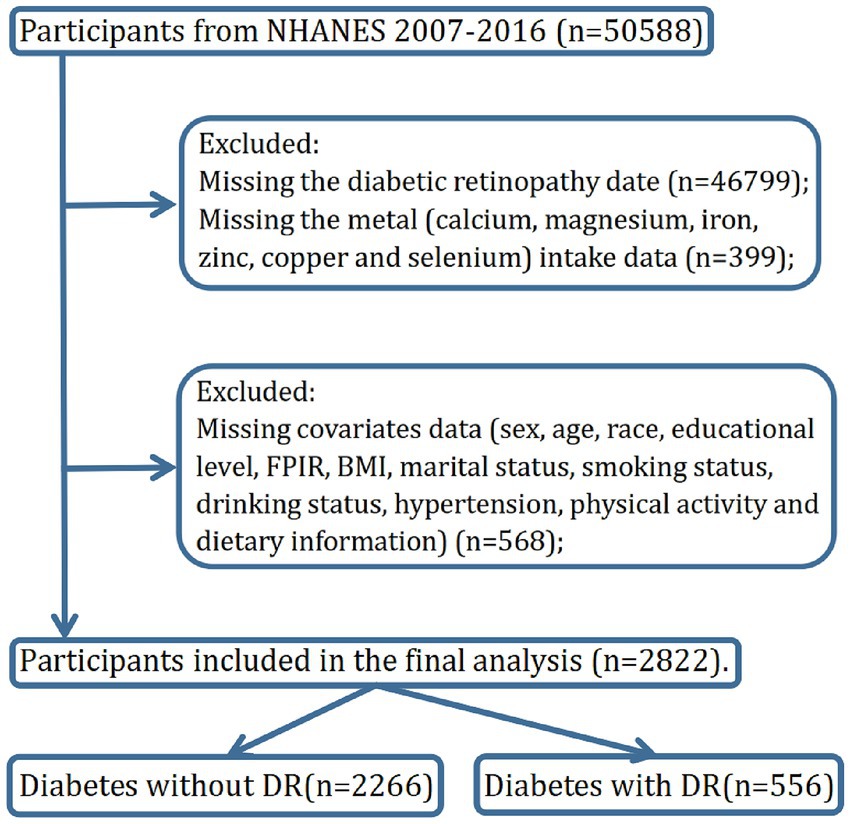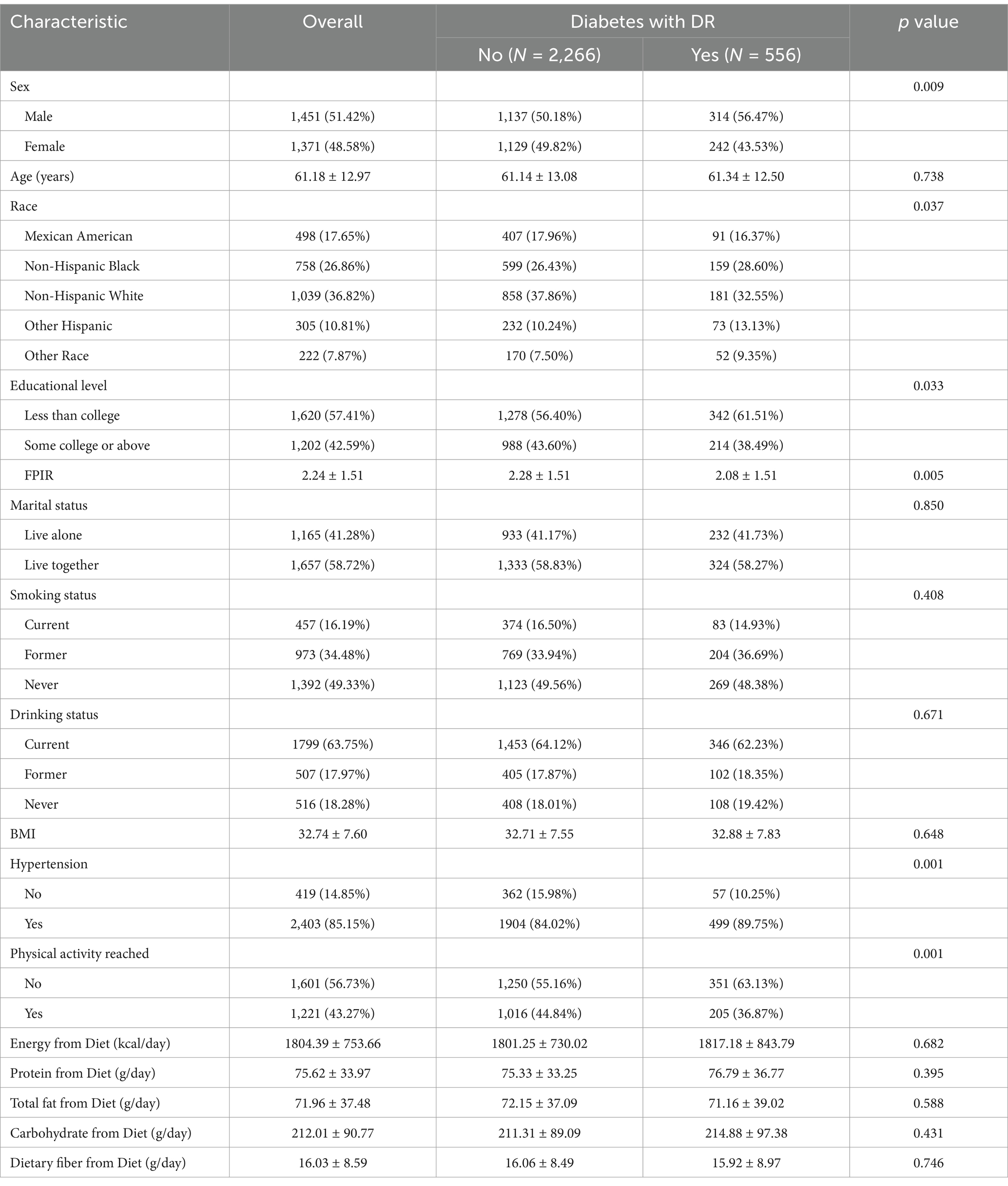- 1Department of Urinary Nephropathy Center, Second Hospital Affiliated to Chongqing Medical University, Chongqing, China
- 2Department of Hepatobiliary Surgery, Second Hospital Affiliated to Chongqing Medical University, Chongqing, China
- 3Department of Clinical Nutrition, Chongqing Red Cross Hospital (People's Hospital of Jiangbei District), Chongqing, China
- 4Department of Plastic and Maxillofacial Surgery, Second Hospital Affiliated to Chongqing Medical University, Chongqing, China
Objective: To investigate the association between dietary metals intake and the risk of diabetic retinopathy (DR) in adults with diabetes.
Methods: Data from 2,822 U. S. adults with diabetes in National Health and Nutrition Examination Survey (NHANES) 2007–2016 were analyzed. Associations between the intake of six dietary metals and DR risk were assessed using multivariable logistic regression, Weighted Quantile Sum (WQS) regression, and Bayesian Kernel Machine Regression (BKMR). Restricted Cubic Spline (RCS) regression examined the dose–response relationship between intake of dietary metal and DR risk. Mediation analysis explored the underlying mechanisms.
Results: Log10-transformed dietary Zinc (Zn) (OR = 0.53, 95% CI 0.35–0.80, p = 0.003) were negatively associated with the DR risk. WQS regression indicated that the combined effects of dietary metals intake were negatively associated with the risk of DR (OR = 0.79, 95% CI 0.61–0.97, p = 0.024), with Zn contributing the most to the reduced risk (36.4%). BKMR model suggested the negative association between the combined intake of 6 metals and DR risk, with Zn receiving the highest posterior inclusion probability (PIP) (0.8574).
Conclusion: In American adults with diabetes, elevated dietary metals intake, especially zinc, may be associated with a lower risk of DR.
1 Introduction
Diabetic microvascular complications significantly threaten the quality of life in individuals with diabetes, with retinopathy being the most prevalent manifestation (1). Numerous studies have consistently identified smoking, alcohol consumption, physical inactivity, and hypertension as major risk factors for diabetic retinopathy (DR) (2, 3). DR is pathologically characterized by progressive retinal damage, primarily mediated through inflammation and oxidative stress, leading to irreversible structural and functional alterations (4, 5). Early-stage DR is generally asymptomatic, making early detection difficult. As DR progresses to advanced stages, it can cause irreversible vision loss and impose substantial therapeutic and socioeconomic burdens (6). Therefore, it is necessary to identify modifiable factors for preventing DR among people with diabetes.
The intake of dietary metals including zinc (Zn), copper (Cu), magnesium (Mg), iron (Fe), calcium (Ca), and selenium (Se), is biologically essential, as these elements collectively participate in enzymatic activation, hemoglobin synthesis, antioxidant defense, bone mineralization, and immune regulation (7, 8). Beyond their essential physiological functions, growing evidence suggests an association between various dietary metals and diabetes risk. In a median 9-year follow-up, He P et al. demonstrated a U-shaped association between dietary Zn intake and incident diabetes, with an inflection point at approximately 9.1 mg/day (9). A prospective cohort study from China found that adequate Fe intake (>23 mg/day) may help prevent diabetes, while excessive Fe intake (>46 mg/day) may increase the risk of diabetes in males (10). Additionally, a cross-sectional study of US adults demonstrated an inverse relationship between dietary Mg intake and diabetes occurrence (OR: 0.56, P trend < 0.001) (11). While these findings clarify the role of dietary metals in diabetes onset, their impact on complications, particularly retinopathy progression, remains underexplored, creating a critical knowledge gap in dietary metals-based complication prevention strategies.
To better understand this relationship between dietary metal intake and DR, we conducted a cross-sectional study using data from the National Health and Nutrition Examination Survey (NHANES) 2007–2016. We applied three regression models to assess both individual and combined associations of six dietary metals with DR risk and to determine the relative importance of each metal. This study may provide population-based evidence on the potential protective role of dietary metals intake against DR, with a particular emphasis on zinc.
2 Materials and methods
2.1 Study participants
The NHANES, conducted by the National Center for Health Statistics (NCHS), employs stratified multistage sampling to collect nationally representative data on health and nutritional status among US civilians (12). The original protocols received NCHS Ethics Review Board approval with documented informed consent from all participants. As this study involved secondary analysis of the NHANES public data (available at https://wwwn.cdc.gov/nchs/nhanes/default.aspx), no additional ethical review was required.
The individuals in this study were included from NHANES 2007–2016 (n = 50,588). Participants with missing DR assessment data were excluded (n = 46,799). The Diabetes Questionnaire (DIQ) item DIQ080, administered only to individuals with diabetes to assess if diabetes has affected the eyes or caused retinopathy, categorized recorded answers as valid (‘Yes’/'No’) or missing (‘Refused’/'Do not know’/'Missing’). Furthermore, participants lacking dietary metal intake data were excluded from the analysis (n = 399). Additionally, participants with no or invalidated data on covariates required for subsequent analyses were also excluded (n = 568), including sex, age, race, educational level, family poverty-income ratio (FPIR), body mass index (BMI), marital status, smoking status, drinking status, hypertension, physical activity, and dietary information. Finally, a total of 2,822 individuals with diabetes were included in this study analysis with 556 individuals with diabetes diagnosed with DR (Figure 1).
2.2 Confirmation of DR
In the questionnaire data of NHANES, the diabetes section (prefix DIQ) encompasses data obtained through personal interviews covering diabetes, prediabetes, insulin/oral hypoglycemic drug use, and diabetic retinopathy. It also incorporates self-reported accounts of diabetes risk factor awareness along with associated medical treatments and personal care routines. In this study, participants were determined to have DR if their physicians informed them that diabetes had affected their eyes or that they had retinopathy (13).
2.3 Assessment of dietary metals
In each NHANES cycle, participants submitted comprehensive dietary records across two non-consecutive 24-h periods, enabling estimation of energy expenditure, nutrient absorption, and food constituent intake. Initial dietary interviews were conducted face-to-face during examinations, with subsequent telephone-based recalls performed 3–10 days thereafter. For these analyses, the average intake of food-derived metals (Zn, Cu, Mg, Fe, Ca, and Se) was calculated over the two recall periods; if only the first day’s data was available, that figure was used instead of an average. Participants were also asked about their supplement use during the same two 24-h periods, and the intake of metals from supplements was averaged over the 2 days if possible. The dietary metals intake was determined by summing both supplement and food-derived sources.
2.4 Covariates and mediators
Various sociodemographic information incorporating sex, age, race, educational level, FPIR, and marital status were comprehensively documented. The FPIR, derived from the ratio of family income to poverty thresholds adjusted for family size, year, and state of residence, utilized the Department of Health and Human Services’ poverty criteria and was categorized into three groups: low (≤1), middle (>1 to ≤4), and high (>4) (14). The smoking and drinking status were categorized as never, former, and current based on previous study (15). BMI (kg/m2) was calculated as weight divided by height squared. Hypertension was identified as having a systolic blood pressure of >130 mm Hg or diastolic blood pressure of >80 mm Hg from an average of 3 measurements or a history of high blood pressure or a history of oral antihypertensive medications (16). Physical activity, gained by the Global Physical Activity Questionnaire (17), was categorized into two groups based on whether participants met the 2018 physical activity guidelines (18). Detailed records of protein, total fat, carbohydrate, dietary fiber, and energy intake derived from foods and supplement consumption were obtained using two 24-h dietary recall administrations. Bilirubin (BIL), albumin (ALB), and γ-glutamyl transferase (GGT) were designated as oxidative stress indicators, while C-reactive protein (CRP), white blood cell (WBC), lymphocyte count, absolute neutrophil count, and alkaline phosphatase (ALP) served as inflammatory markers. These parameters have been extensively applied in NHANES research for quantifying oxidative stress and inflammatory responses (19–22).
2.5 Statistical analysis
Baseline characteristic data were grouped by diabetic retinopathy (DR) status. Continuous variables were presented means with standard deviation (SD) and categorical variables as frequencies with percentages. Group comparisons were conducted using t-tests for continuous variables and chi-squared tests for categorical variables.
The intake of dietary metals was log10-transformed due to skewed distributions then divided into quartiles. Multivariable logistic regression was utilized to evaluate associations between dietary metal intakes and DR prevalence. Three hierarchical models were constructed: Model 1 was adjusted for sex, age, race, educational level, and marital status; Model 2 further adjusted for FPIR, BMI, smoking status, drinking status, and hypertension; Model 3 further adjusted for physical activity, protein, total fat, carbohydrate, fiber, and energy intake. The first quartile (Q1) was set as the control group.
To assess the combined effects of the six dietary metals on DR prevalence, a WQS regression was applied by calculating a weighted linear index and assigning corresponding weights. A 1000-time bootstrapping procedure was used to construct WQS indices in both positive and negative directions. When the WQS index was significantly nonzero, corresponding weights were calculated to identify the relative contribution of each dietary metal within the index to the incidence of DR. The dataset was randomly split into training set (40%) and validation set (60%) according to previous research (22).
Additionally, the Bayesian variable selection framework was also utilized to explore the overall effects of six dietary metals mixtures on the odds of DR. To be specific, the BKMR model assessed the overall impact of mixtures levels at specific quartiles compared to the medians. All metal intakes were log10-transformed and standardized before analysis. The posterior inclusion probability (PIP) was calculated to quantify the relative importance of each metal (PIP > 0.5 indicating strong contribution). Moreover, univariate and bivariate exposure-response functions were applied to assess both the individual effects and interactions of dietary metals, while simultaneously considering the other dietary metals at the 25th, 50th, and 75th percentiles. This model conducted 10,000 iterations via the Markov Chain Monte Carlo algorithm after accounting for all covariates.
Restricted Cubic Spline (RCS) regression was conducted to examine potential dose–response relationships between log10-transformed dietary Zn intake and DR incidence (23). Subgroup analyses were performed stratified by age, sex, race, educational level, FPIR, marital status, smoking status, drinking status, BMI, hypertension, and physical activity.
Linear regression models were used to assess the associations between log10-transformed dietary Zn intake and the biomarkers of inflammation and oxidative stress. Mediation analysis was performed to estimate direct and indirect effects of dietary Zn on DR risk via inflammatory and oxidative stress pathways, with 1,000 bootstraps after adjusting all covariates.
In this study, data were not weighted as adjustments for demographic factors were already made (24). The statistical significance level was set at a p value of < 0.05. R 4.4.2 software was utilized for all statistical analyses.
3 Results
3.1 Characteristics of participants
After excluding ineligible participants, a total of 2,822 individuals remained for further analysis. All included participants had diabetes, and 556 of them were diagnosed with DR. Among the qualified participants, As shown in Table 1, there were significant differences in sex, race, educational level, family poverty income ratio (FPIR), hypertension, and physical activity among the qualified participants (all p < 0.05).
3.2 Dietary metals intake and DR risk in logistic regression model
To assess the relationship between six dietary metals intake and the odds of DR among individuals with diabetes, we employed univariate and multivariate logistic regression. As shown in Table 2, an inverse relationship between log10-transformed dietary Zn and Cu intake and the risk of DR was consistently observed across the crude model, model 1, model 2, and model 3. In model 3, the increase in log10-transformed dietary Zn (OR = 0.53, 95% CI 0.35–0.80, p = 0.003) and Cu (OR = 0.52, 95% CI 0.32–0.82, p = 0.005) intake was significantly correlated with a decreased prevalence of DR. Furthermore, when participants were categorized by the quartiles of log10-transformed dietary metal intake, individuals in the highest quartile group of dietary Zn intake (ORQ4 vs. Q1 = 0.62, 95% CI 0.45–0.86, p = 0.004, p for trend = 0.005) and dietary Cu intake (ORQ4 vs. Q1 = 0.63, 95% CI 0.45–0.88, p = 0.007, p for trend = 0.01) had a lower risk of DR compared to those in the lowest quartile group through logistic regression model 3. The rest of the four dietary metals intake had no significance to the occurrence of DR in individuals with diabetes.
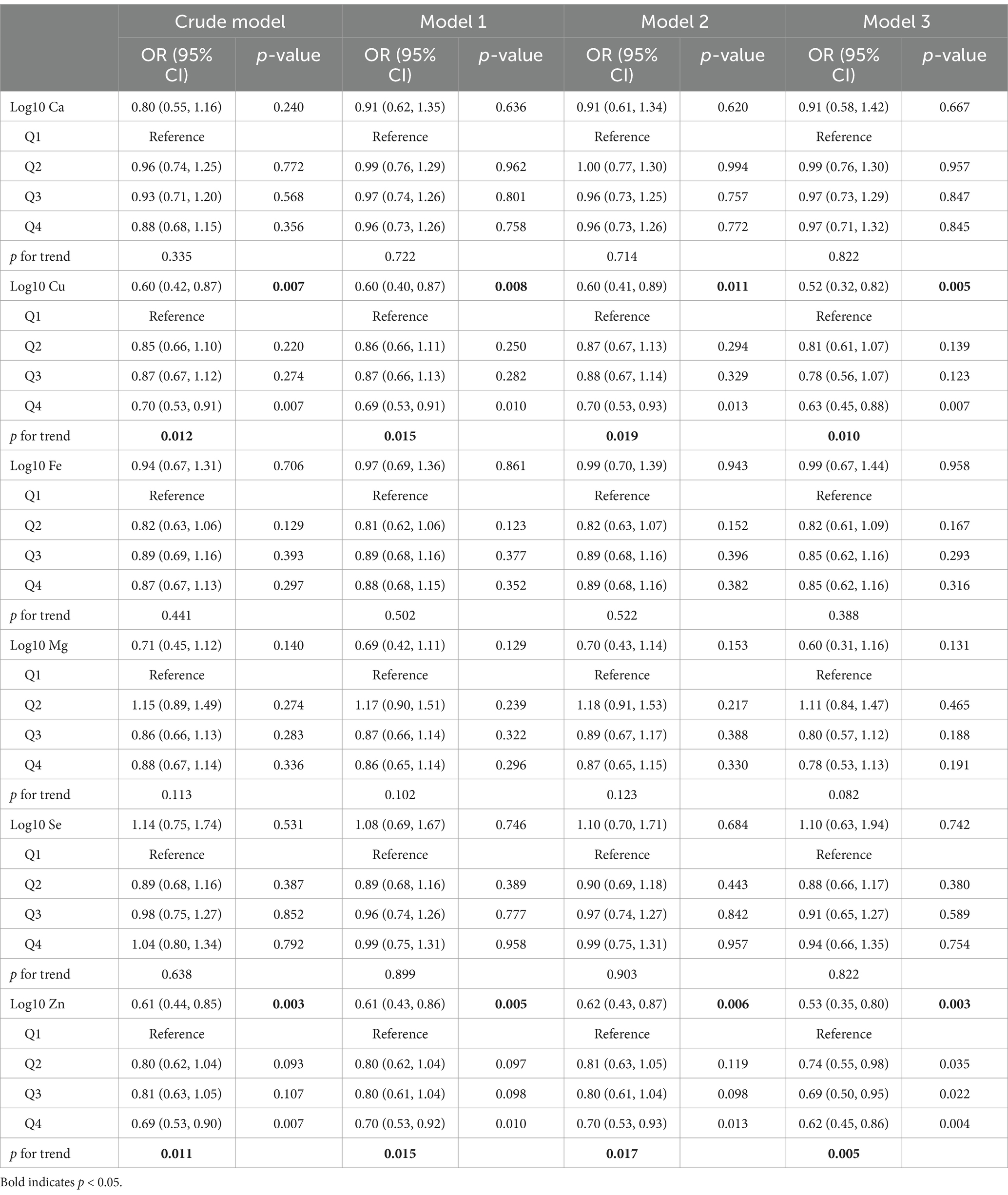
Table 2. Multivariate logistic regression analysis of Log10-transformed metals intake for the prevalence of DR in diabetic population.
3.3 Dietary metals intake and DR risk in WQS model
We applied the WQS model to examine the association between the combined effects of the six dietary metals intake and the prevalence of DR in individuals with diabetes. As shown in Table 3, the WQS index indicated that the combined effects of dietary metals intake were negatively associated with the prevalence of DR (Crude model: OR = 0.83, 95% CI 0.70–0.95, p = 0.005; Model 1: OR = 0.83, 95% CI 0.70–0.96, p = 0.008; Model 2: OR = 0.82, 95% CI 0.69–0.95, p = 0.008; Model 3: OR = 0.79, 95% CI 0.61–0.97, p = 0.024). In the fully adjusted covariates WQS regression (Figure 2), dietary Zn intake received the highest weight of 0.364 for DR risk in the negative direction, compared to weights of 0.209, 0.203, 0.109, 0.062, and 0.052 for Cu, Mg, Fe, Ca, and Se, respectively. In the positive direction, the combined effects of dietary metals intake showed no significant association with the odds of DR after fully adjusting for covariates (Crude model: OR = 0.95, 95% CI 0.83–1.06, p = 0.379; Model 1: OR = 0.93, 95% CI 0.79–1.06, p = 0.263; Model 2: OR = 0.92, 95% CI 0.78–1.05, p = 0.224; Model 3: OR = 0.93, 95% CI 0.75–1.12, p = 0.499), with dietary Zn intake receiving the lowest weight of 0.009 for DR risk, as shown in Table 3 and Supplementary Figure 1.
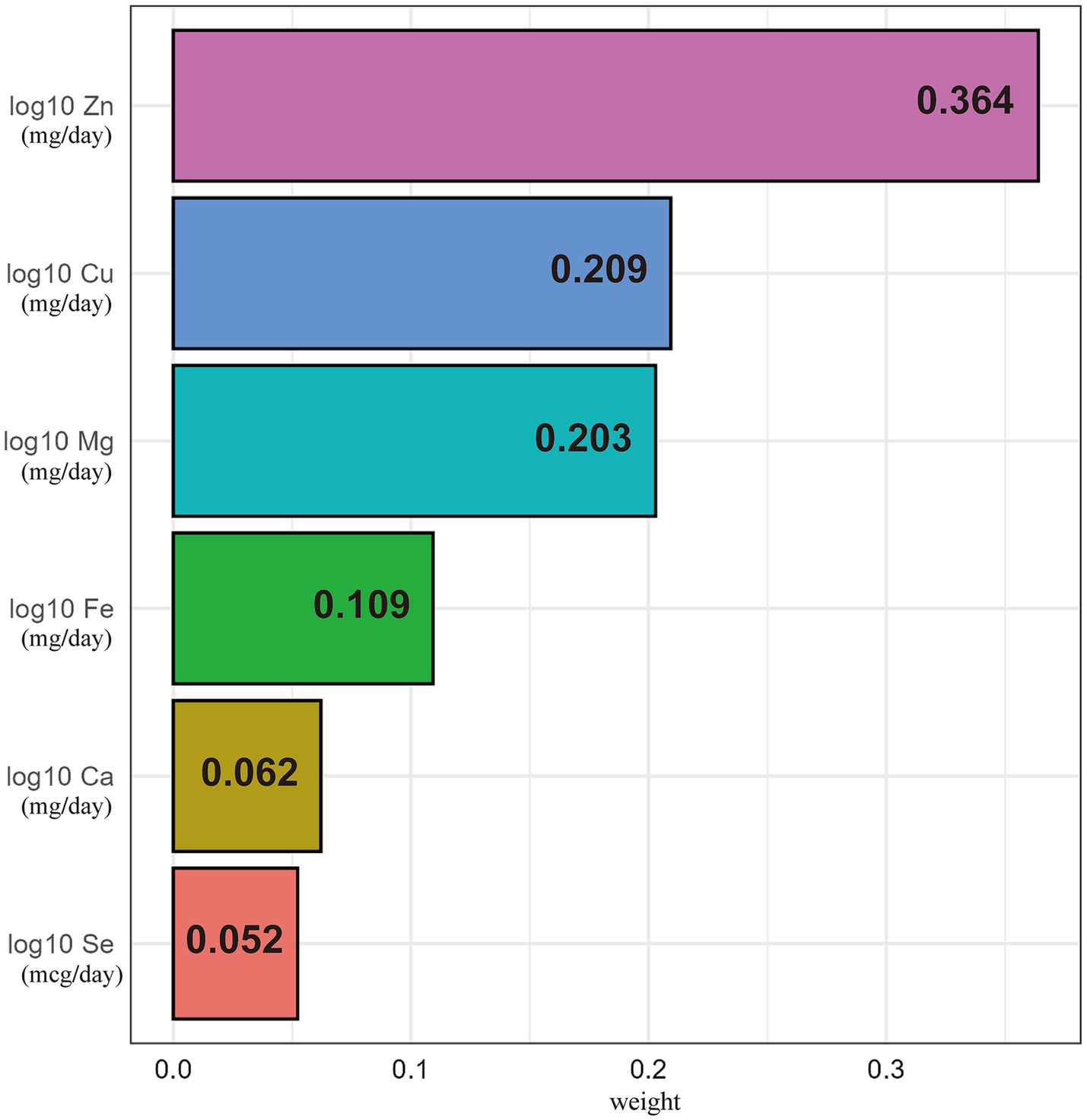
Figure 2. The WQS model weights of dietary metals on DR odds in negative direction with all covariates adjusted.
3.4 Dietary metals intake and DR risk in BKMR model
In the BKMR model, the risk of DR among individuals with diabetes was decreased for the combined intake of six dietary metals mixtures above the 50th percentile compared to the medians (Figure 3A). Figure 3B illustrated an inverse association between dietary Zn intake and the risk of DR, with the intake levels of all other dietary metals held constant at the median. Supplementary Table 1 presented a summary of the PIPs from the BKMR model. Among the dietary metals, Zn intake displayed the highest PIP (0.8574) in relation to the prevalence of DR in individuals with diabetes. Additionally, Supplementary Figure 2 possibly indicated a negative association between dietary Zn intake and DR prevalence compared to other dietary metals, when controlling for the 25th, 50th, and 75th percentiles of other dietary metals, although this association did not reach statistical significance. Furthermore, Supplementary Figure 3 indicated that there were no potential interactions among dietary metals intake.

Figure 3. The comprehensive analysis of BKMR model on dietary metals and DR risk. (A) Overall effect of the six dietary metals mixture on DR risk. (B) Univariate exposure-response function between each dietary metal intake and DR risk when the other metal intake was simultaneously fixed at 50th percentile.
3.5 Further analysis of the relationship between dietary Zn intake and DR
In the RCS regression model, the log10-transformed dietary Zn intake was found to have an inverse association with the risk of DR in a linear dose–response manner (p for non-linear = 0.2063, p for overall = 0.0041), as shown in Figure 4. The subgroup analysis results are presented in Figure 5, indicating that the inverse correlation between dietary Zn intake and DR was not modified by various factors such as age, sex, race, educational level, marital status, FPIR, smoking status, drinking status, BMI, hypertension and physical activity (all p for interaction > 0.05). As shown in Supplementary Table 2, the results of the linear analysis suggested that dietary Zn intake was significantly correlated with the concentration of serum ALB with all covariates controlled (Model 3: β = 2.25, 95% CI 1.33–3.82, p = 0.003). Additionally, the increase of serum ALB could reduce the incidence of DR in individuals with diabetes (Model 3: OR = 0.95, 95% CI 0.92–0.97, p < 0.001) (Supplementary Table 3). According to Table 4, the results of the mediation analysis showed that serum ALB level mediated the negative association between dietary Zn intake and DR prevalence after fully adjusting for covariates (Total effect = −0.128321, 95% CI -0.232569--0.047959, p = 0.002; Indirect effect = −0.008067, 95% CI -0.015724--0.002561, p = 0.002; Mediation proportions = 0.062866, 95% CI 0.018701–0.163004, p = 0.004).
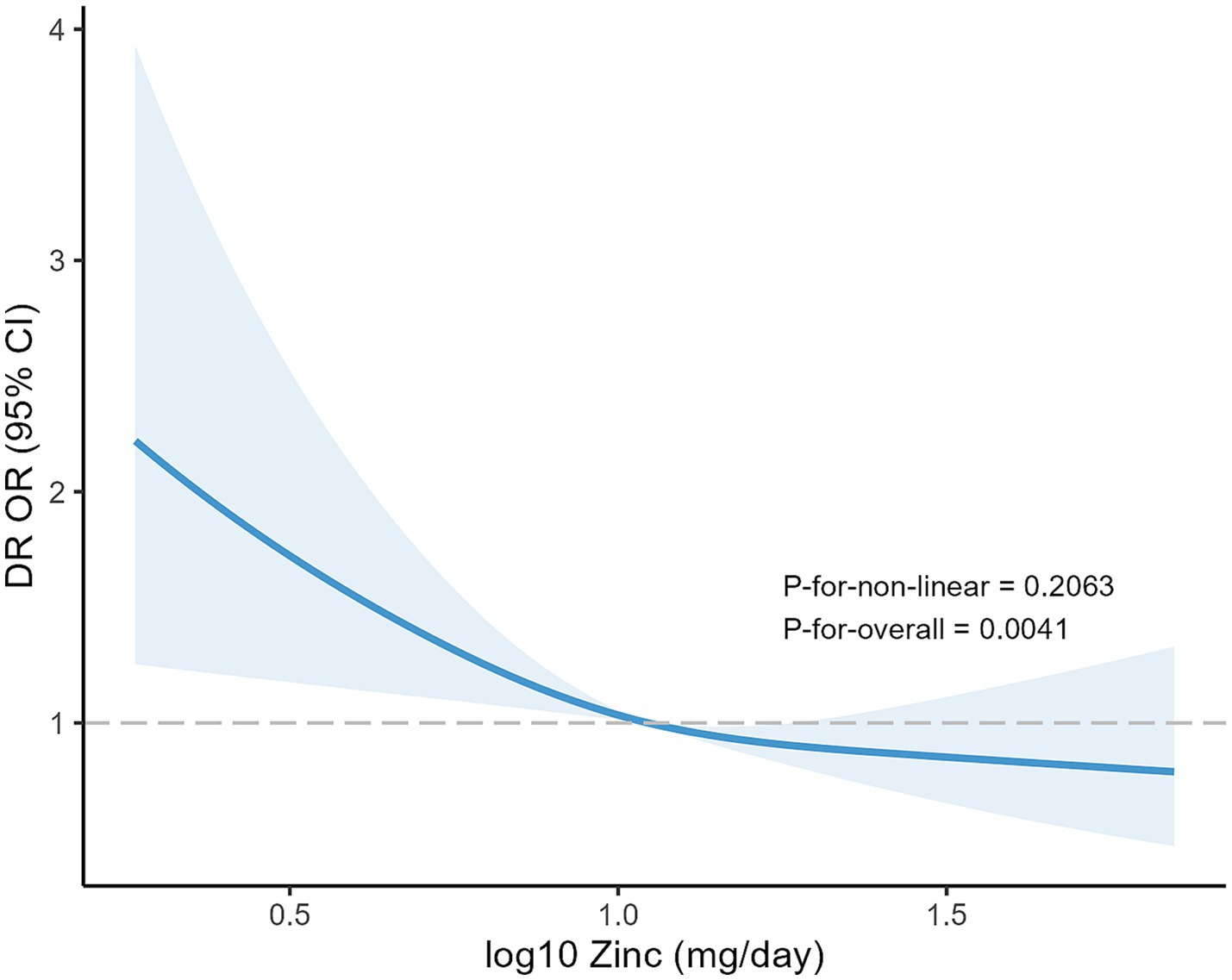
Figure 4. Thorough description of DR risk across the log10-transformed dietary Zn intake by RCS model.
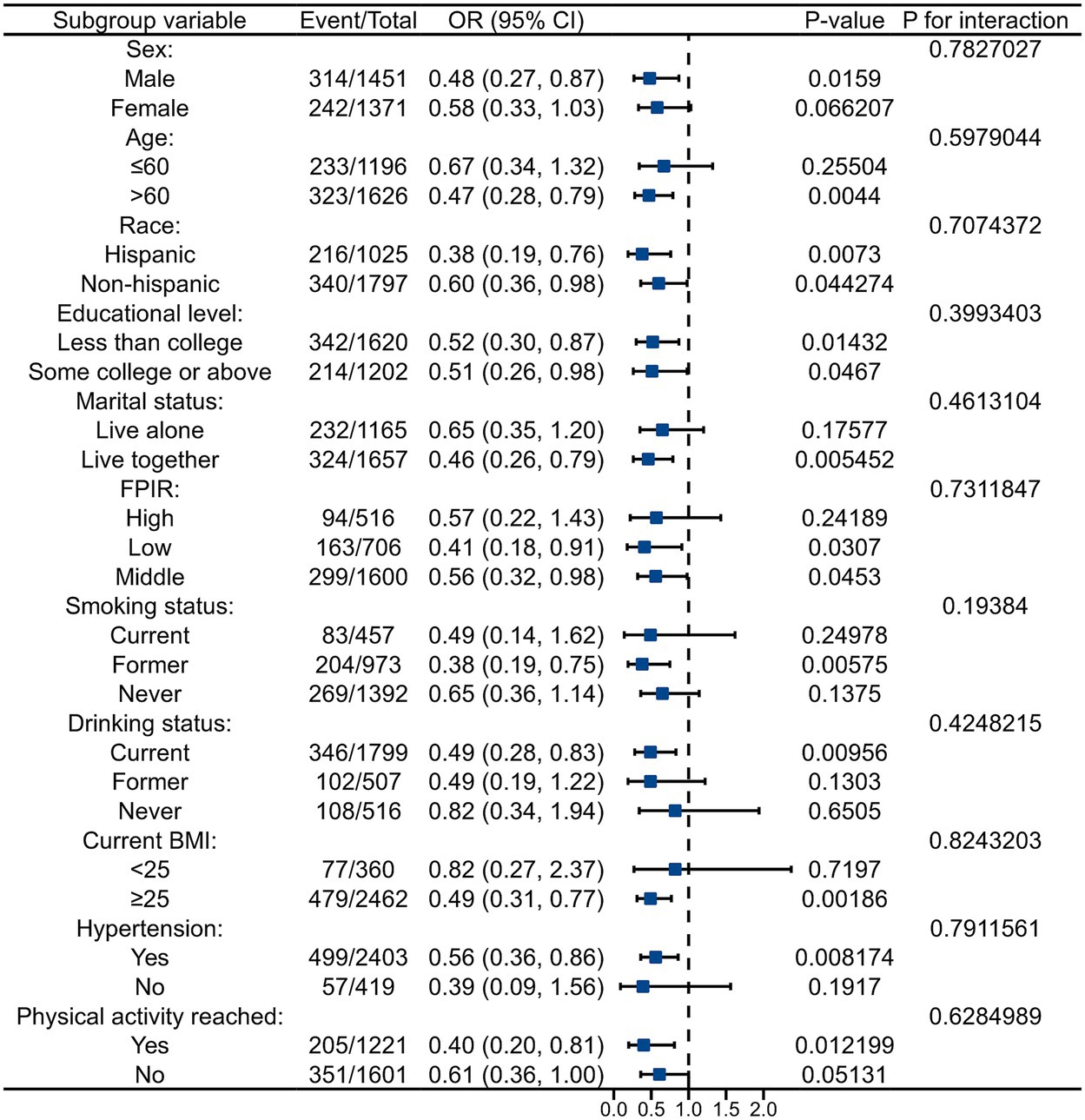
Figure 5. Subgroup analyses on the association of the log10-transformed dietary Zn intake with the risk of DR.

Table 4. Mediating effect and proportions of inflammation and oxidative stress biomarkers between Zn intake and DR odds in diabetic population.
4 Discussion
This study examined the association between dietary metals intake and the risk of diabetic retinopathy (DR) in the diabetic population aged 20 from NHANES 2007–2016. We found that higher intake of multiple dietary metals, especially zinc (Zn), was associated with lower DR risk across multiple statistical models including logistic regression, WQS regression, and BKMR. Notably, Zn was identified as the most protective metal, with a dose-dependent inverse association observed in RCS regression. Mediation analysis further revealed that serum albumin (ALB) partially mediates the negative association, suggesting a potential biological pathway.
Our findings align with prior studies reporting lower serum Zn levels in individuals with diabetes (25–28). A randomized controlled trial has confirmed that Zn supplementation can improve glycemic control in individuals with diabetes (26). Meanwhile lower serum zinc levels are associated with an increased risk of diabetic complications, suggesting a potential link between zinc status and retinal health (25, 29, 30). Additionally, a randomized controlled trial demonstrated that Zn supplementation can decelerate the progression of vision loss in individuals with macular degeneration (31). Our study further demonstrated that Zn intake is negatively associated with the risk of DR.
Zn deficiency may contribute to DR via several mechanisms, including impaired antioxidant defenses, enhanced inflammation, endothelial dysfunction, and dysregulated apoptosis—all of which are critical in DR pathogenesis (32–39). Serum ALB, the main plasma transporter of Zn (40, 41), also plays a protective role through its antioxidant and anti-inflammatory properties (42). Previous study has suggested that low serum albumin levels may increase the permeability of the optic disc and surrounding blood vessels, leading to subclinical disc edema (43). Our findings highlight the significant mediating role of albumin in the association between Zn intake and DR. The mediation effect accounted for a considerable proportion of the total effect (6.29, 95% CI 1.87–16.30%). These results suggest that albumin may be a key mechanism through which Zn deficiency contributes to the development of DR.
To the best of our knowledge, this is the first population-based study to assess the joint effects of multiple dietary metals on DR risk. By integrating multiple analytical approaches, we validated the robustness of our findings and identified Zn as a key protective component. These results may provide population-level evidence for considering Zn intake in DR prevention strategies.
However, several limitations should be acknowledged. The retrospective design precludes causal inference, and the predominantly White American sample limits generalizability. Future prospective studies in more diverse populations are needed to confirm our findings. In clinical practice, Zn supplementation could be explored as a potential preventive strategy against DR, particularly in individuals with low Zn or ALB levels.
5 Conclusion
Among American adults with diabetes from NHANES 2007–2016, higher dietary intake of certain metals, particularly zinc, was associated with a lower risk of diabetic retinopathy. Serum albumin may serve as a potential mediator of this protective effect.
Data availability statement
The datasets presented in this article are not readily available because the dataset employed in this study was accessed from the NCHS, accessible via the following web link: https://wwwn.cdc.gov/nchs/nhanes. Requests to access the datasets should be directed to https://wwwn.cdc.gov/nchs/nhanes.
Ethics statement
The requirement of ethical approval was waived by National Center for Health Statistics Ethics Review Board for the studies involving humans because as this study involved secondary analysis of the NHANES public data (available at https://www.cdc.gov/nchs/nhanes/index.htm), no additional ethical review was required. The studies were conducted in accordance with the local legislation and institutional requirements. The ethics committee/institutional review board also waived the requirement of written informed consent for participation from the participants or the participants’ legal guardians/next of kin.
Author contributions
CZ: Conceptualization, Data curation, Formal analysis, Methodology, Writing – original draft. HP: Conceptualization, Formal analysis, Methodology, Writing – original draft. QL: Writing – review & editing. HF: Writing – review & editing. KZ: Conceptualization, Funding acquisition, Project administration, Writing – review & editing. AZ: Conceptualization, Funding acquisition, Project administration, Writing – review & editing.
Funding
The author(s) declare that financial support was received for the research and/or publication of this article. This study was funded by the National Nature Science Foundation of China, grant number 82102337; the Natural Science Foundation of Chongqing, China, grant number CSTB2022NSCQ-MSX0899; and the Special Funding for Postdoctoral Research Project of Chongqing, grant number 2021XM3071.
Acknowledgments
We would like to thank the NHANES participants and the staff members for their contribution to data collection and their meticulous efforts in data collection, organization, and maintenance.
Conflict of interest
The authors declare that the research was conducted in the absence of any commercial or financial relationships that could be construed as a potential conflict of interest.
Generative AI statement
The authors declare that no Gen AI was used in the creation of this manuscript.
Publisher’s note
All claims expressed in this article are solely those of the authors and do not necessarily represent those of their affiliated organizations, or those of the publisher, the editors and the reviewers. Any product that may be evaluated in this article, or claim that may be made by its manufacturer, is not guaranteed or endorsed by the publisher.
Supplementary material
The Supplementary material for this article can be found online at: https://www.frontiersin.org/articles/10.3389/fnut.2025.1595788/full#supplementary-material
References
1. Yau, JW, Rogers, SL, Kawasaki, R, Lamoureux, EL, Kowalski, JW, Bek, T, et al. Global prevalence and major risk factors of diabetic retinopathy. Diabetes Care. (2012) 35:556–64. doi: 10.2337/dc11-1909
2. Su, Z, Wu, Z, Liang, X, Xie, M, Xie, J, Li, H, et al. Diabetic retinopathy risk in patients with unhealthy lifestyle: a Mendelian randomization study. Front Endocrinol. (2022) 13:1087965. doi: 10.3389/fendo.2022.1087965
3. Li, B, Zhou, C, Gu, C, Cheng, X, Wang, Y, Li, C, et al. Modifiable lifestyle, mental health status and diabetic retinopathy in U.S. adults aged 18-64 years with diabetes: a population-based cross-sectional study from Nhanes 1999-2018. BMC Public Health. (2024) 24:11. doi: 10.1186/s12889-023-17512-8
4. Spencer, BG, Estevez, JJ, Liu, E, Craig, JE, and Finnie, JW. Pericytes, inflammation, and diabetic retinopathy. Inflammopharmacology. (2020) 28:697–709. doi: 10.1007/s10787-019-00647-9
5. Kang, Q, and Yang, C. Oxidative stress and diabetic retinopathy: molecular mechanisms, Pathogenetic role and therapeutic implications. Redox Biol. (2020) 37:101799. doi: 10.1016/j.redox.2020.101799
6. Rein, DB, Zhang, P, Wirth, KE, Lee, PP, Hoerger, TJ, McCall, N, et al. The economic burden of major adult visual disorders in the United States. Arch Ophthalmol. (2006) 124:1754–60. doi: 10.1001/archopht.124.12.1754
7. Lakatos, B, Szentmihályi, K, Vinkler, P, Balla, J, and Balla, G. The role of essential metal ions in the human organism and their Oral supplementation to the human body in deficiency states. Orv Hetil. (2004) 145:1315–9.
8. Grzeszczak, K, Kwiatkowski, S, and Kosik-Bogacka, D. The role of Fe, Zn, and cu in pregnancy. Biomol Ther. (2020) 10:1176. doi: 10.3390/biom10081176
9. He, P, Li, H, Liu, M, Zhang, Z, Zhang, Y, Zhou, C, et al. U-shaped association between dietary zinc intake and new-onset diabetes: a Nationwide cohort study in China. J Clin Endocrinol Metab. (2022) 107:e815–24. doi: 10.1210/clinem/dgab636
10. He, J, Fang, A, Yu, S, Shen, X, and Li, K. Dietary Nonheme, Heme, and Total Iron intake and the risk of diabetes in adults: results from the China health and nutrition survey. Diabetes Care. (2020) 43:776–84. doi: 10.2337/dc19-2202
11. Han, M, Zhang, Y, Fang, J, Sun, M, Liu, Q, Ma, Z, et al. Associations between dietary magnesium intake and hypertension, diabetes, and hyperlipidemia. Hypertens Res. (2024) 47:331–41. doi: 10.1038/s41440-023-01439-z
12. Curtin, LR, Mohadjer, LK, Dohrmann, SM, Montaquila, JM, Kruszan-Moran, D, Mirel, LB, et al. The National Health and nutrition examination survey: sample design, 1999-2006. Vital Health Stat. (2012) 2:1–39.
13. Zhang, Y, Liu, X, Zhang, X, Li, L, Li, Q, Geng, H, et al. Association between serum heavy metal levels and diabetic retinopathy in Nhanes 2011-2020. Sci Rep. (2024) 14:1268. doi: 10.1038/s41598-024-51749-6
14. Zhang, YB, Chen, C, Pan, XF, Guo, J, Li, Y, Franco, OH, et al. Associations of healthy lifestyle and socioeconomic status with mortality and incident cardiovascular disease: two prospective cohort studies. BMJ (Clinical research ed). (2021) 373:n604. doi: 10.1136/bmj.n604
15. Wang, K, Qian, D, Hu, Y, Cheng, Y, Ge, S, and Yao, Y. Nut consumption and effects on chronic kidney disease and mortality in the United States. Am J Nephrol. (2022) 53:503–12. doi: 10.1159/000524382
16. Golabi, P, Paik, JM, Harring, M, Younossi, E, Kabbara, K, and Younossi, ZM. Prevalence of high and moderate risk nonalcoholic fatty liver disease among adults in the United States, 1999-2016. Clin Gastroenterol Hepatol. (2022) 20:2838–47.e7. doi: 10.1016/j.cgh.2021.12.015
17. He, F, Li, Y, Hu, Z, and Zhang, H. Association of Domain-Specific Physical Activity with depressive symptoms: a population-based study. Eur Psychiatry. (2022) 66:e5. doi: 10.1192/j.eurpsy.2022.2350
18. Piercy, KL, Troiano, RP, Ballard, RM, Carlson, SA, Fulton, JE, Galuska, DA, et al. The physical activity guidelines for Americans. JAMA. (2018) 320:2020–8. doi: 10.1001/jama.2018.14854
19. Zang, X, Qin, W, Xiong, Y, Xu, A, Huang, H, Fang, T, et al. Using three statistical methods to analyze the association between aldehyde exposure and markers of inflammation and oxidative stress. Environ Sci Pollut Res Int. (2023) 30:79437–50. doi: 10.1007/s11356-023-27717-4
20. Ferguson, KK, Loch-Caruso, R, and Meeker, JD. Exploration of oxidative stress and inflammatory markers in relation to urinary phthalate metabolites: Nhanes 1999-2006. Environ Sci Technol. (2012) 46:477–85. doi: 10.1021/es202340b
21. Muñoz Aguilera, E, Leira, Y, Miró Catalina, Q, Orlandi, M, Czesnikiewicz-Guzik, M, Guzik, TJ, et al. Is systemic inflammation a missing link between periodontitis and hypertension? Results from two large population-based surveys. J Intern Med. (2021) 289:532–46. doi: 10.1111/joim.13180
22. Huang, Q, Wan, J, Nan, W, Li, S, He, B, and Peng, Z. Association between manganese exposure in heavy metals mixtures and the prevalence of sarcopenia in us adults from NHANES 2011-2018. J Hazard Mater. (2024) 464:133005. doi: 10.1016/j.jhazmat.2023.133005
23. Desquilbet, L, and Mariotti, F. Dose-response analyses using restricted cubic spline functions in public Health Research. Stat Med. (2010) 29:1037–57. doi: 10.1002/sim.3841
24. Zhang, Y, Dong, T, Hu, W, Wang, X, Xu, B, Lin, Z, et al. Association between exposure to a mixture of phenols, pesticides, and phthalates and obesity: comparison of three statistical models. Environ Int. (2019) 123:325–36. doi: 10.1016/j.envint.2018.11.076
25. Anetor, JI, Senjobi, A, Ajose, OA, and Agbedana, EO. Decreased serum magnesium and zinc levels: atherogenic implications in Type-2 diabetes mellitus in Nigerians. Nutr Health. (2002) 16:291–300. doi: 10.1177/026010600201600403
26. Al-Maroof, RA, and Al-Sharbatti, SS. Serum zinc levels in diabetic patients and effect of zinc supplementation on glycemic control of type 2 diabetics. Saudi Med J. (2006) 27:344–50.
27. Walter, RM Jr, Uriu-Hare, JY, Olin, KL, Oster, MH, Anawalt, BD, Critchfield, JW, et al. Copper, zinc, manganese, and magnesium status and complications of diabetes mellitus. Diabetes Care. (1991) 14:1050–6. doi: 10.2337/diacare.14.11.1050
28. Saharia, GK, and Goswami, RK. Evaluation of serum zinc status and glycated hemoglobin of type 2 diabetes mellitus patients in a tertiary Care Hospital of Assam. J Lab Physicians. (2013) 5:30–3. doi: 10.4103/0974-2727.115923
29. Devi, TR, Hijam, D, Dubey, A, Debnath, S, Oinam, P, Devi, NT, et al. Study of serum zinc and copper levels in type 2 diabetes mellitus. Int J Contemp Med Res. (2016) 2:1036–40. doi: 10.21276/ijmrp.2016.2.5.006
30. Luo, YY, Zhao, J, Han, XY, Zhou, XH, Wu, J, and Ji, LN. Relationship between serum zinc level and microvascular complications in patients with type 2 diabetes. Chin Med J. (2015) 128:3276–82. doi: 10.4103/0366-6999.171357
31. Newsome, DA, Swartz, M, Leone, NC, Elston, RC, and Miller, E. Oral zinc in macular degeneration. Arch Ophthalmol. (1988) 106:192–8. doi: 10.1001/archopht.1988.01060130202026
32. Jansen, J, Karges, W, and Rink, L. Zinc and diabetes--clinical links and molecular mechanisms. J Nutr Biochem. (2009) 20:399–417. doi: 10.1016/j.jnutbio.2009.01.009
33. Kowluru, RA, Zhong, Q, and Santos, JM. Matrix Metalloproteinases in diabetic retinopathy: potential role of Mmp-9. Expert Opin Investig Drugs. (2012) 21:797–805. doi: 10.1517/13543784.2012.681043
34. Prasad, AS, Beck, FW, Bao, B, Fitzgerald, JT, Snell, DC, Steinberg, JD, et al. Zinc supplementation decreases incidence of infections in the elderly: effect of zinc on generation of cytokines and oxidative stress. Am J Clin Nutr. (2007) 85:837–44. doi: 10.1093/ajcn/85.3.837
35. Tang, J, and Kern, TS. Inflammation in diabetic retinopathy. Prog Retin Eye Res. (2011) 30:343–58. doi: 10.1016/j.preteyeres.2011.05.002
36. Maret, W, and Sandstead, HH. Zinc requirements and the risks and benefits of zinc supplementation. J Trace Elem Med Biol. (2006) 20:3–18. doi: 10.1016/j.jtemb.2006.01.006
37. Cruz, KJ, de Oliveira, AR, and Marreiro, DN. Antioxidant role of zinc in diabetes mellitus. World J Diabetes. (2015) 6:333–7. doi: 10.4239/wjd.v6.i2.333
38. Allington, C, Shamovsky, IL, Ross, GM, and Riopelle, RJ. Zinc inhibits P75ntr-mediated apoptosis in Chick neural retina. Cell Death Differ. (2001) 8:451–6. doi: 10.1038/sj.cdd.4400831
39. Chabosseau, P, and Rutter, GA. Zinc and diabetes. Arch Biochem Biophys. (2016) 611:79–85. doi: 10.1016/j.abb.2016.05.022
40. Blindauer, CA, Harvey, I, Bunyan, KE, Stewart, AJ, Sleep, D, Harrison, DJ, et al. Structure, properties, and engineering of the major zinc binding site on human albumin. J Biol Chem. (2009) 284:23116–24. doi: 10.1074/jbc.M109.003459
41. Coverdale, JPC, van den Berg, HA, Khazaipoul, S, Bridgewater, HE, Stewart, AJ, and Blindauer, CA. Albumin-mediated extracellular zinc speciation drives cellular zinc uptake. Chem Commun (Camb). (2022) 58:7384–7. doi: 10.1039/d2cc02278h
42. Tabata, F, Wada, Y, Kawakami, S, and Miyaji, K. Serum albumin redox states: more than oxidative stress biomarker. Antioxidants (Basel). (2021) 10:503. doi: 10.3390/antiox10040503
Keywords: diabetic retinopathy, dietary metals intake, weighted quantile sum, Bayesian kernel machine regression, NHANES
Citation: Zhang C, Peng H, Lang Q, Fang H, Zhang K and Zhao A (2025) Association between dietary multi-metal intake and the risk of diabetic retinopathy: a population-based study. Front. Nutr. 12:1595788. doi: 10.3389/fnut.2025.1595788
Edited by:
Aziz-Ur-Rahim Bacha, Harbin Institute of Technology, ChinaReviewed by:
Shujaat Ahmad, Shaheed Benazir Bhutto University, PakistanFarid Ul Haque, COMSATS, Pakistan
Copyright © 2025 Zhang, Peng, Lang, Fang, Zhang and Zhao. This is an open-access article distributed under the terms of the Creative Commons Attribution License (CC BY). The use, distribution or reproduction in other forums is permitted, provided the original author(s) and the copyright owner(s) are credited and that the original publication in this journal is cited, in accordance with accepted academic practice. No use, distribution or reproduction is permitted which does not comply with these terms.
*Correspondence: Andong Zhao, emFkb25nQGhvc3BpdGFsLmNxbXUuZWR1LmNu; Keqin Zhang, bW5zYnp4MjAxOUAxNjMuY29t; Haiyang Peng, cGVuZ2hhaXlhbmcwMjE5QDEyNi5jb20=
†These authors have contributed equally to this work and share first authorship
 Chaohua Zhang
Chaohua Zhang Haiyang Peng
Haiyang Peng Qin Lang3
Qin Lang3 Haoyu Fang
Haoyu Fang Keqin Zhang
Keqin Zhang